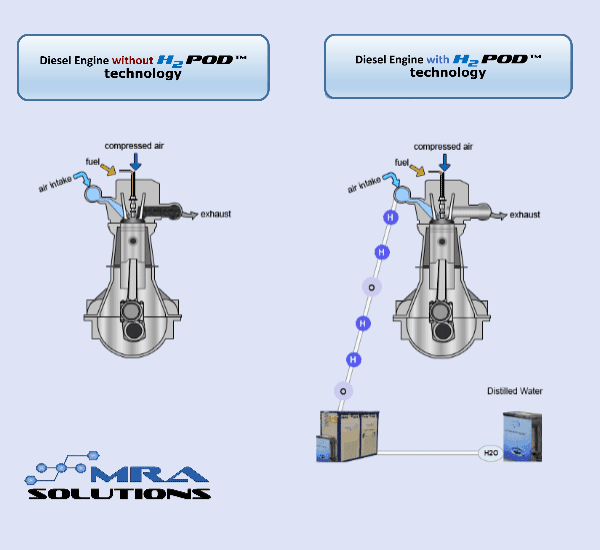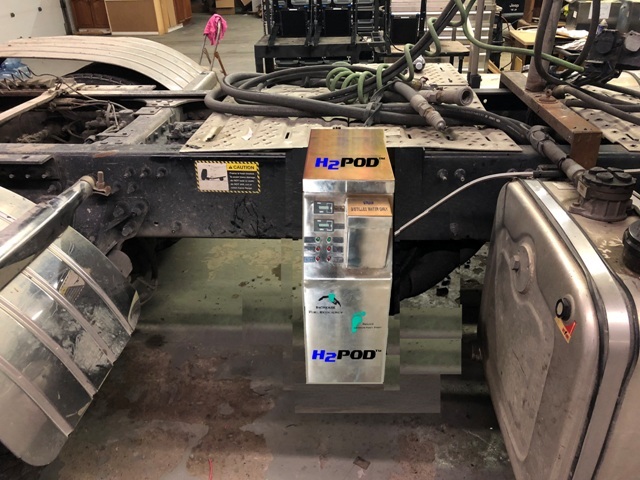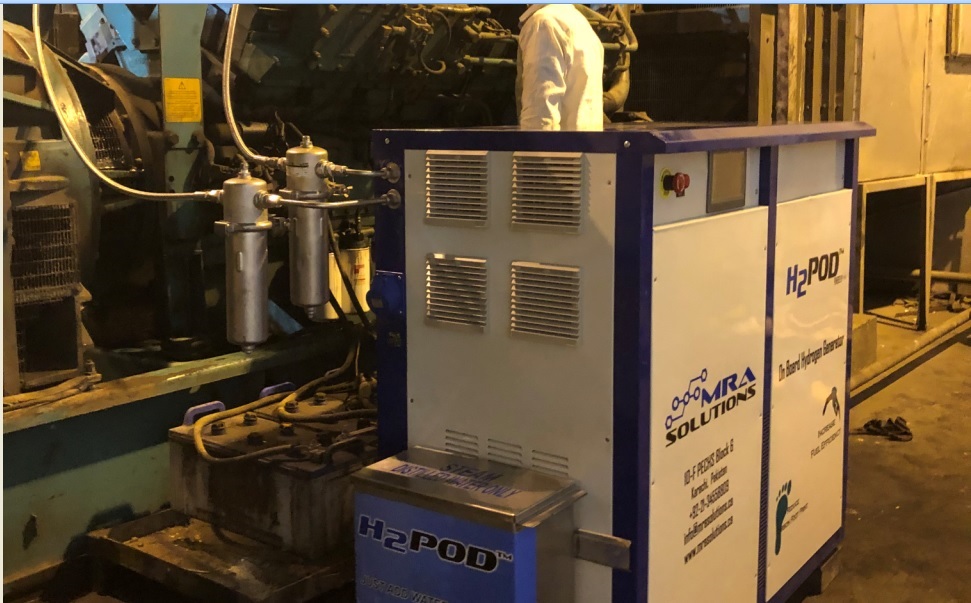
The H2POD™ is a Hydrogen Generating System for internal combustion applications. The H2POD™ produces a mixture of hydrogen and oxygen gases, on demand, through a controlled electrolysis process. It is designed to work on any internal combustion engine. It operates on demand only when the engine is running thus eliminates the need for on-board Hydrogen storage and addresses all safety concerns
- Canadian Technology
- Robust and designed for long life
- Requires no maintenance
- Only operator input is refilling water reservoir with distilled water
- Payback can be less than one year

- Increased Fuel Efficiency
- Reduced Emissions and Carbon FootPrint
- Increased Horse Power and Torque
- Longer Engine Life
- Reduced Maintenance Cost
- Eligible for Emission Credits

- Freight Trucks
- Generator Sets
- Buses
- Heavy Construction & Mining Equipments
- Trains
- Marine Applications
- HVAC and more
Upgrading to Hydrogen Injection, the Next Big Step
You can save a minimum of 10%, and up to 30% of your fuel expenditures through the use of hydrogen Injection. Done right, the net result is more complete combustion and significant improvement in fuel economy
Hydrogen Injection provides a more complete burn that reduces the soot and particulate matter up to 80%. You get less downtime and greater productivity
Increasing emission regulation continues to reduce profitability in an already low margin / high saturation industry.
This technology will assist clients in meeting Climate Change Plan Initiatives. It reduces fuel consumption & maintenance costs creating Real, On Market, Quantifiable, Varifiable, Tradable,Bankable, Saleable, Carbon offse Credits.
How It Works

THE SCIENCE BEHIND H2POD™ TECHNOLOGY
The H2POD™ System produces a mixture of hydrogen on demand with oxygen gases through a controlled electrolysis process. These gases are delivered to the engine’s air intake, where they are mixed with the air and enter the engine’s cylinders, participating in the combustion process.
Adding hydrogen through the H2POD™ System to a diesel engine improves overall engine combustion efficiency by producing a more complete burn of the air-fuel mixture. This results in a decrease in greenhouse gases, reduced emissions and decreased fuel consumption.
The Properties and Benefits of Hydrogen
Hydrogen burns significantly faster than diesel fuel, and with a significantly Lower Flammability Limit (LFL, or sometimes LEL). Both of these factors lead to small amounts of hydrogen having significant effects on diesel combustion. The first and most important effect, for our purposes, is that the hydrogen promotes a faster and more complete burn of the diesel fuel, closer to the top of the power stroke in a diesel engine. This leads to increased thermal efficiency, which necessarily leads to less fuel spent for a given amount of work. In addition, hydrogen has a significant stabilizing effect on cycle-to-cycle variations in combustion, which leads to further efficiency improvements.
The addition of hydrogen to the combustion cycle also has significant effects on emissions, both due to the properties of hydrogen in combustion itself, and due to the increased thermal efficiency resulting from the hydrogen-enhanced combustion. A faster and more complete burn leads to dramatic reductions in unburnt hydrocarbons (Particulate Matter), and in carbon monoxide (CO). The increased fuel economy leads to a reduction in carbon dioxide levels (CO2), and the higher thermal efficiency of the combustion cycle leads to lower exhaust temperatures, which leads to a reduction in nitrous oxides (NOx).
The Application of Hydrogen utilizing the H2POD™ technology
The modern diesel internal combustion engines burns approximately 70% of diesel fuel in the combustion process. The other 30% turns into unburned hydrocarbons that clog up the DPF and EGRs while the remainder contaminates the oil, and blows out the stack producing pollution and smog. Hydrogen burns 14-times faster than diesel and expands by 20,000-times its volume. When introduced via a delivery line on the vacuum side of the turbo, the hydrogen excites the diesel molecules, increasing the speed of the burn and therefore burning more of the diesel fuel. Simply put, by burning more of the fuel, there is less soot left over. By reducing the quantity of soot there is less for the DPF to filter and less to clog up the EGR valve. Less fuel left over after the burn equals fewer pollutants, better mileage and cleaner running engines.



